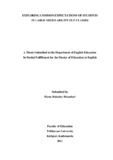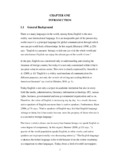Please use this identifier to cite or link to this item:
https://elibrary.tucl.edu.np/handle/123456789/761| Title: | Exploring Common Expectations of Students in Large MixedAbility ELT Classes |
| Authors: | Bhandari, Hasta Bahadur |
| Keywords: | English Language;Language teaching;teaching skills |
| Issue Date: | 2011 |
| Publisher: | Department of English Education |
| Institute Name: | Central Department of Education |
| Level: | Masters |
| Abstract: | This present study entitled 'Exploring Common Expectations of Students inLarge Mixed Ability ELT Classes' was intended to find out the commonexpectations of students in large mixed ability ELT classes. In order to fulfillthe objectives of the study, 100 secondary level students, i.e.Grade 10 studentswere selected from the five schools of the Kathmandu valley through purposivenon-random sampling procedure. A set of questionnaire was the research toolfor eliciting the required information for the study. The findings of the studyshowed that in every large mixed ability ELT classes, there are students ofdifferent abilities and they have their different expectations in the classroom. Itwas found that majority of the students are in favour of small class and theyexpect different sections for poor and bright students. It was also found thatmost of the students except varietiesinteaching strategies and they expect toget an opportunity to speak in the classroom. Similarly, it was found thatjudicious use of English with limited use of mother tongue can be significantlyhelpful in large mixed ability ELT classroom. It was also found that mixedability classes facilitate collaborative learning and helps the teacher to be a realteacher. This thesis is organized in four chapters along with references and appendix atthe end. The first chapter presents the general background, the concept of largeclasses, challenges and opportunities of a large mixed ability ELT class. It alsoincludes strategies for coping with the challenges. The second chapter isconcerned with the methodology used in the study, under which sources ofdata, sampling procedure, tools for data collection, process of data collectionand limitations of the study are described. The third chapter provides thecomprehensive picture of the analysis and interpretation of the data. The dataare analyzed and interpreted underthe five headings. Finally, chapter fourincludes findings and recommendations based on the analysis andinterpretation of the study. |
| URI: | http://elibrary.tucl.edu.np/handle/123456789/761 |
| Appears in Collections: | English Language Education |
Files in This Item:
| File | Description | Size | Format | |
|---|---|---|---|---|
| Cover page.pdf | 30.08 kB | Adobe PDF |  View/Open | |
| chapter.pdf | 516.44 kB | Adobe PDF |  View/Open |
Items in DSpace are protected by copyright, with all rights reserved, unless otherwise indicated.
